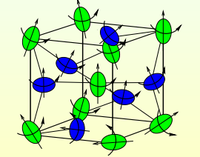The mechanics of the Cosserat media — различия между версиями
Данил (обсуждение | вклад) |
Данил (обсуждение | вклад) |
||
| Строка 2: | Строка 2: | ||
[[Файл:Cosserat.png|thumb|200px| Magnetic materials (Kelvin’s medium — special Cosserat medium with particle posessing large spin)]] | [[Файл:Cosserat.png|thumb|200px| Magnetic materials (Kelvin’s medium — special Cosserat medium with particle posessing large spin)]] | ||
Cosserat medium is a continuum whose point bodies (particles) have rotational degrees of freedom. Examples of Cosserat media: heterogeneous materials with granular structure, composites under loading that causes rotation of (sufficiently rigid) grains (superplastic materials, acoustic metamaterials). Cosserat medium is a particular case of complex medium. Its point-body is rigid. There are other more complex media, e.g. where a point-body is deformable (protein chains, porous media, etc.) It is only a first step to the world of enriched continua. Theory is based on the fundamental laws of mechanics (balance of forces, couples, energy) and, for inelastic media, 2nd law of the thermodynamics, symmetry considerations and material frame indifference. Another branch is the microstructural approach. Experimental methods: under development. We need experiments to determine the moduli. Most of them are based on the experiments on waves (mechanics of magnetic and piezoelectric materials, mechanics of granular materials, rotational seismology...). | Cosserat medium is a continuum whose point bodies (particles) have rotational degrees of freedom. Examples of Cosserat media: heterogeneous materials with granular structure, composites under loading that causes rotation of (sufficiently rigid) grains (superplastic materials, acoustic metamaterials). Cosserat medium is a particular case of complex medium. Its point-body is rigid. There are other more complex media, e.g. where a point-body is deformable (protein chains, porous media, etc.) It is only a first step to the world of enriched continua. Theory is based on the fundamental laws of mechanics (balance of forces, couples, energy) and, for inelastic media, 2nd law of the thermodynamics, symmetry considerations and material frame indifference. Another branch is the microstructural approach. Experimental methods: under development. We need experiments to determine the moduli. Most of them are based on the experiments on waves (mechanics of magnetic and piezoelectric materials, mechanics of granular materials, rotational seismology...). | ||
| + | |||
| + | == Basic equations == | ||
| + | <math>\dot(x) = D{\dot x}^3 + Bx + L</math>; | ||
Версия 23:36, 11 января 2015
Introduction
Cosserat medium is a continuum whose point bodies (particles) have rotational degrees of freedom. Examples of Cosserat media: heterogeneous materials with granular structure, composites under loading that causes rotation of (sufficiently rigid) grains (superplastic materials, acoustic metamaterials). Cosserat medium is a particular case of complex medium. Its point-body is rigid. There are other more complex media, e.g. where a point-body is deformable (protein chains, porous media, etc.) It is only a first step to the world of enriched continua. Theory is based on the fundamental laws of mechanics (balance of forces, couples, energy) and, for inelastic media, 2nd law of the thermodynamics, symmetry considerations and material frame indifference. Another branch is the microstructural approach. Experimental methods: under development. We need experiments to determine the moduli. Most of them are based on the experiments on waves (mechanics of magnetic and piezoelectric materials, mechanics of granular materials, rotational seismology...).
Basic equations
;
